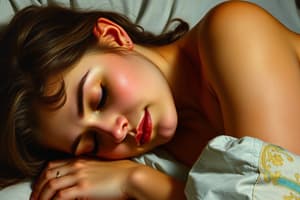Podcast
Questions and Answers
What is the main regulator of the etiology of bruxism according to the text?
What is the main regulator of the etiology of bruxism according to the text?
- Genetic factors
- Dental interventions
- Neural and psychologic factors (correct)
- Occlusal factors
Which factor is associated with increased waking oral parafunction (WOP) according to the text?
Which factor is associated with increased waking oral parafunction (WOP) according to the text?
- Dental interventions
- Substance abuse
- Genetic factors
- Stress and psychologic status (correct)
What does WOP (Waking Oral Parafunction) include based on the text?
What does WOP (Waking Oral Parafunction) include based on the text?
- Sleep talking
- Bracing/thrusting of mandible with no tooth contact (correct)
- Hypnogogic hallucinations
- Gum chewing
What is considered to have damaging effects on teeth, TMJ, and jaws due to overuse?
What is considered to have damaging effects on teeth, TMJ, and jaws due to overuse?
Which factor has a direct correlation with TMD pain according to the text?
Which factor has a direct correlation with TMD pain according to the text?
What is the gold standard for a definite diagnosis of sleep bruxism (SB)?
What is the gold standard for a definite diagnosis of sleep bruxism (SB)?
What is the most common method used in clinical examinations to diagnose sleep bruxism according to the text?
What is the most common method used in clinical examinations to diagnose sleep bruxism according to the text?
What are intraoral devices used for in the diagnosis of sleep bruxism according to the text?
What are intraoral devices used for in the diagnosis of sleep bruxism according to the text?
What type of therapy is mentioned as one of the management approaches for sleep bruxism in the text?
What type of therapy is mentioned as one of the management approaches for sleep bruxism in the text?
What do genetic factors contribute to according to the text?
What do genetic factors contribute to according to the text?
What is one of the alternate approaches mentioned in the text for managing sleep bruxism?
What is one of the alternate approaches mentioned in the text for managing sleep bruxism?
What is the definition of sleep bruxism?
What is the definition of sleep bruxism?
How is sleep bruxism diagnosed?
How is sleep bruxism diagnosed?
What percentage of sleep bruxism episodes are seen in a cyclic pattern?
What percentage of sleep bruxism episodes are seen in a cyclic pattern?
What causes rhythmic masticatory muscle activity (RMMA) associated with sleep bruxism?
What causes rhythmic masticatory muscle activity (RMMA) associated with sleep bruxism?
What is the difference between primary and secondary sleep bruxism?
What is the difference between primary and secondary sleep bruxism?
What role does sleep bruxism play in obstructive sleep apnea (OSA)?
What role does sleep bruxism play in obstructive sleep apnea (OSA)?
What is the relationship between sleep bruxism and insomnia?
What is the relationship between sleep bruxism and insomnia?
What is the most common preceding element for neurodegenerative issues such as dementia and Parkinson's in relation to sleep bruxism?
What is the most common preceding element for neurodegenerative issues such as dementia and Parkinson's in relation to sleep bruxism?
How does awake bruxism differ from sleep bruxism?
How does awake bruxism differ from sleep bruxism?
What is the standard of care for comorbid sleep bruxism?
What is the standard of care for comorbid sleep bruxism?
What causes tooth wear due to sleep bruxism?
What causes tooth wear due to sleep bruxism?




